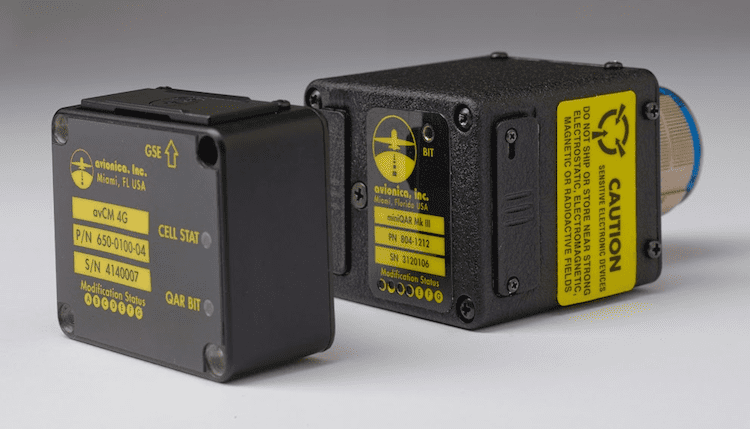
Avionica’s mini QAR Mk III with avCM communications module. Photo courtesy of Avionica
Avionica has unveiled the second version of its automated aircraft data synchronization service, avSYNC 2.0, with new cloud computing and improved cellular and Wi-Fi downloading and uploading capabilities.
The Miami, Florida-based avionics manufacturer describes avSYNC as a web-hosted software as a service (SAAS) application designed to optimize the process used by commercial aircraft maintenance engineers and technicians’ processes for acquiring and analyzing aircraft performance data. Now, under avSYNC 2.0, Avionica has added the power of Microsoft’s Azure cloud computing service as part of a new product line.
Avionics International recently caught up with Avionica VP of Business Development Sean Reilly to discuss the public unveiling of avSYNC 2.0. Reilly confirmed Boeing 737 private charter operator Miami Air as the launch customer for avSYNC 2.0 and noted that 20 airlines using avSYNC are upgrading to 2.0 as well.
He describes avSYNC 2.0 as focusing on improving Avionica’s ability to support the downloading and uploading of aircraft data, information and software to and from the aircraft.
“We have built the platform around the Microsoft Azure Cloud Services. This not only allows us to make the data easily accessible, but it enables us to keep data in-country, such as Europe [and] China and never travel back to the United States, unless required,” said Reilly.
Aircraft equipped with either Avionica’s mini QAR and avCM communications module or the avRDC with avCM are capable of using avSYNC. The technology’s cache and forward configuration allows aircraft mini QARs and other devices to periodically connect to the virtual private network (VPN) and servers. Aircraft data such as engine temperatures and pressures are conveyed directly to and the company’s mini QAR, secureLINK, aviONS and avRDC avionics over encrypted VPN tunnels.

An input/output diagram showing how Avionica’s avSYNC service works. Image courtesy of Avionica
According to Reilly, avSYNC’s aircraft data transfer capabilities are more focused on enabling FOQA data download and upload while the aircraft is on the ground. While airborne, a different set of data in “small snapshots” is available, although that is not coordinated with avSYNC, he said. The avSYNC service records flight data from the aircraft’s digital flight data acquisition unit after the aircraft has landed and uses a cellular or local Wi-Fi network connection to transmit the airline’s requested aircraft FOQA and other data requirements.
The minimum local system requirements for operators using avSYNC include two gigabytes of random access memory for the virtual machine. Systems must also feature dual core or better computer processing capability.
“The 2.0 software has increased security features and redundancy for downloading data at different location around the world. This helps keep data in-country if the airline requires. Also, avSYNC 2.0 gives us the ability to push large data content [ such as FMS databases] to the aircraft, not only download QAR data from the aircraft,” said Reilly.
Avionica has expanded and extended the onboard capabilities of its satellite communications and data transmission avionics in recent years through new industry partnerships, supplemental type certificates and industry partnerships. In May, the company formed a new joint venture with GE Aviation, extending an ongoing aircraft edge processing and wireless connectivity partnership the two companies first established in 2016. On avSYNC 2.0, Avionica is working with another division of GE as well.
“We’ve rolled avSYNC 2.0 out to airlines and business jet operators working with our GE Digital partners for C-FOQA data analytics,” said Reilly.